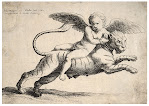
There's a thunderstorm blowing in right now, but the weather here was beautiful today--sunny and about 70 degrees. It's definitely spring. Not much is blooming yet, except for the daffodils, but all the critters are out and about. I even saw a bullfrog poking his head up beside the pond.
The birds all seem to be courting, especially the downy woodpeckers. We always have plenty of them around here, but there are scads of them this year. It's odd how bird populations seem to cycle. One year there'll be a glut of, say, bluejays, the next it's wrens, then thrashers, and so on. I can often pinpoint a cause for the shifts that happen around my house. For instance, we've lost most of our owls and pileated woodpeckers because a nearby housing development took out a lot of old trees. On the other hand, our thrasher population has rebounded because the feral cat population has declined, which is mostly thanks to the coyotes.
Anyway, this seems to be the year of the downy woodpecker, especially in two of the parks where I walk. I've seen one pair after another the past few days. Downy males are famously unchivalrous. They'll often chase their own mates away from a food source, but during the spring honeymoon period that competitiveness is put aside, and you'll see males and females happily feeding close together. They'll creep along a tree within inches of each other, looking like little tuxedoed mice--it's very cute.
All woodpeckers are marvels of biological engineering, but the downy seems particularly impressive. It's so tiny, just about 6 inches long, and has a small beak, but it still manages to harvest its food from the same trees where big pileateds feed. Chalotte Hilton Green has a great description of how they do it in her book, Birds of the South**, in a passage headed (no kidding), "Tongue a Marvelous Mechanism."
"It would seem almost impossible for the downy to get the grub out of this small hole, but he can extend his long tongue far beyond the beak, and its tip is hard and thorny and covered with short, backward-slanting hooks acting like a spear, which, when thrust into the grub, pulls it out easily. The slender bones that support this long tongue slide in a muscular sheath that extends around the back of the head and over the crown. Apparently ... it is the contraction of these muscles which pushes the bones down and forward."[181]
I don't have much interest in grubs, but just once I'd like to fish an olive out of a martini that way.
**(University of North Carolina Press, 1933, 1995)
Photo from Wikipedia


3 comments:
I long for your avian pleasures !
Cunnin' little creatures, they are.
Thank you, puss.
The boy goldfinches on my thistle sock are starting to put on their courting clothes, so I think we can safely assume that spring is here, and never mind the prediction of snow tonight.
That reminds me, I need to put my thistle socks back out. They all got wrecked in the last bad storm. I want to see those little yellow guys at my house.
Chaya, doesn't Boston have any place for birdwatching? What a thing to be deprived of--I'm glad you enjoy my little outings, at least.
Post a Comment